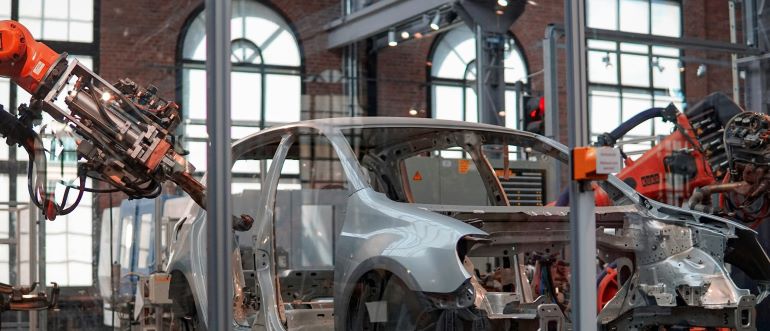
Manufacturing is known for its precision, efficiency and relentless pursuit of innovation. To keep up with the high product demand, the manufacturing industry is always pushing the boundaries of what is possible — seeking more efficient methods and technologies to drive progress. The integration of AI into robotics design is not new, but it continues to prove a game-changer in the landscape of manufacturing with promises to transform traditional workflows and unlock higher levels of productivity and adaptability.
AI’s role in Enhancing Precision and Accuracy in Robotic Operations
AI’s capabilities in computer vision and object recognition empower robots to perceive and interpret their surroundings with acuity. This heightened perception allows robots to navigate complex environments, manipulate objects with surgical precision, and execute tasks that were once considered too intricate for automated systems and too slow for humans to execute rapidly.
Additionally, AI plays a pivotal role in predictive maintenance and fault detection for robotic systems. By analyzing large amounts of sensor data and leveraging machine learning algorithms, AI can identify potential failures or anomalies before they occur. This proactive approach minimizes downtime, reduces maintenance costs and ensures consistent and reliable operation, enhancing overall efficiency and productivity.
Through continuous monitoring and analysis of operational data, AI-powered robots can, in real time, adjust their movements and trajectories, and force outputs to achieve optimal performance. This adaptability enables robots to compensate for environmental variables, material inconsistencies, or unexpected factors, ensuring tasks are executed with unwavering precision and accuracy.
How AI Enables Robots to Adapt to Changing Environments and Make Autonomous Decisions
The integration of AI into robotics design has empowered robots to perceive, learn and respond to complex situations in real time, reforming their adaptability and decision-making processes. Through advanced machine learning algorithms and sensor fusion technologies, AI enables robots to continuously process and analyze vast amounts of data from their surroundings. This continuous learning process allows robots to discern patterns, recognize anomalies and make informed decisions based on contextual information.
A key component of AI-enabled adaptability is machine learning algorithms, which enable robots to continually refine their decision-making processes based on past experiences. By analyzing historical data and identifying correlations between actions and outcomes, robots can iteratively improve their performance and adapt their behavior to suit evolving circumstances.
Additionally, AI-enhanced robots leverage sensor fusion technologies to create a comprehensive understanding of their environment. By integrating data from multiple sensors, such as cameras, LiDAR and tactile sensors, robots can perceive and interpret spatial information, identify obstacles and navigate complex terrains with precision and agility.
The impact of AI-enabled adaptability and autonomous decision-making is already evident across various manufacturing sectors. For instance, in warehouse logistics, AI-powered robots can dynamically adjust their routes and operations based on real-time inventory levels to optimize efficiency and throughput. Similarly, in automotive manufacturing, AI-enabled robots can adapt their assembly processes to accommodate variations in vehicle specifications, ensuring consistent quality and production efficiency.
The Potential of AI-Enhanced Robots to Reorganize Workflows and Collaboration
One of the most promising avenues in AI and robotics is the rise of collaborative robots (or “cobots”), designed to work alongside humans in shared environments. These AI-powered cobots can perceive and respond to human movements, gestures and even emotional cues, facilitating a seamless collaboration that leverages the strengths of both humans and machines. In manufacturing settings, AI-enhanced cobots can assist human workers in tasks requiring precision and dexterity, augmenting their capabilities and reducing the risk of human error.
Moreover, AI-enhanced robots have the potential to automate complex and dangerous tasks, paving the way for safer and more efficient industrial operations. From exploring hazardous environments to performing intricate surgical procedures, these intelligent machines can take on challenges once deemed too risky or intricate for traditional robotic systems. By relieving humans from repetitive and hazardous tasks, AI-enhanced robots not only enhance workplace safety but also free up human workers to focus on more strategic and creative endeavors.
Integrating AI into robotic systems opens up new realms of intelligent process optimization and resource allocation. By continuously analyzing operational data and identifying areas for improvement, AI algorithms can optimize workflows, minimize waste and maximize resource utilization — driving efficiency and competitiveness in manufacturing operations.
Moreover, this integration represents a paradigm shift in manufacturing, bringing in a future where intelligent machines work in harmony with human workers to achieve unprecedented levels of productivity and innovation. By embracing AI-enhanced robots and utilizing their capabilities to streamline workflows and enhance collaboration, manufacturers can position themselves as leaders in the fourth industrial revolution — driving growth, prosperity and positive change in the global economy.


